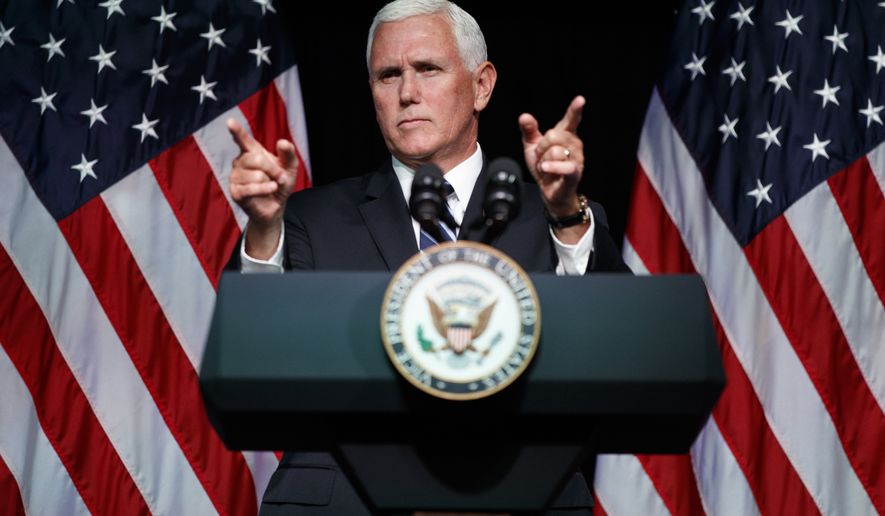The U.S. “Space Force” will become a reality by 2020, Vice President Mike Pence and Defense Secretary James N. Mattis promised Thursday, laying out an ambitious timeline to set up the first new branch of the armed forces in nearly 75 years and making the case that Americans must prepare for space threats from Russia, China, North Korea and other hostile actors.
Speaking Thursday morning at the Pentagon, Mr. Pence said the Trump administration sees space as the next frontier in war and is ready to take dramatic action to prepare for conflicts.
Still, the proposal faces an uncertain fate in Congress, particularly if Democrats capture either the House or Senate in November elections.
“Now the time has come to write the next great chapter in the history of our armed forces, to prepare for the next battlefield. … The time has come to establish the United States Space Force,” the vice president said. “What was once peaceful and uncontested is now crowded and adversarial. Today, other nations are seeking to disrupt our space-based systems and challenge American supremacy in space as never before. … The United States will not shrink from this challenge.”
Many retired military officials and some currently in the Defense Department privately express reservations about the Space Force as a wholly separate branch of the military.
Over the past several weeks, there was widespread speculation that the Pentagon would pursue half-measures — such as establishing a unified space command — but avoid creating an entirely new service.
Mr. Pence’s comments Thursday, along with a detailed Pentagon report explaining how the Space Force will be handled, put an end to that speculation and demonstrate that military leaders — at least publicly — are now in step with the White House on space policy.
“Like the other military branches, the Space Force will organize, train, and equip forces to protect national security interests in the physical domain of space. The Space Force will accelerate and unify the Department’s space efforts and enable the delivery of next-generation space capabilities faster than potential adversaries can evolve,” the Pentagon says in its report. “The Space Force will grow the world’s most capable national security space workforce.”
Mr. Trump weighed in immediately after the vice president’s remarks.
“Space Force all the way!” the president tweeted.
Neither Mr. Pence nor Mr. Mattis offered any details on what it would cost to stand up the Space Force, but the administration reportedly will seek about $8 billion in funding. A formal proposal to establish the Space Force will be included in next year’s National Defense Authorization Act, and that bill will include all funding details.
Mr. Pence said the administration already is working with Congress on the issue.
SEE ALSO: Donald Trump’s ‘Space Force’ meets resistance in Pentagon, insiders say
“We’re building bipartisan support for our plan,” he said. “Next February in the president’s budget we will call on the Congress to marshal the resources we need to stand up the Space Force.”
Rep. Mike Rogers, Alabama Republican and one of Congress’ most outspoken Space Force proponents, said it’s past time for the U.S. to move forward.
“We in the House have been warning for years about the threats to our space assets and the unacceptably slow pace to develop more capable space systems,” he tweeted.
Critics raised concern that the force will simply lead to more bureaucracy inside the Pentagon.
“It is a waste of money,” said Stephen Ellis, executive vice president of the watchdog group Taxpayers for Common Sense. “A completely separate branch of the military won’t necessarily help the U.S. lead in space. It will, however, create a lot of waste and duplication.”
Mr. Pence and Mr. Mattis said the force won’t be rolled out until 2020, but the Defense Department is taking preparatory steps immediately.
First, the Pentagon said it will stand up a unified “Space Command” that will oversee all space operations in each branch of the military, similar in structure to U.S. Central Command, U.S. Africa Command and other combatant commands responsible for specific areas.
Second, the Defense Department will set up a “Space Operations Force” comprising “space war fighters.”
“The Space Operations Force will provide the human capital needed to develop, field, and integrate space capabilities into multi-domain war fighting,” the Pentagon says in its report.
The Pentagon also will set up a space development agency that will serve as the central hub for acquisition of materials needed to stand up the force.
The Defense Department also will appoint an assistant secretary of defense for space who will report directly to Mr. Mattis.
• Ben Wolfgang can be reached at bwolfgang@washingtontimes.com.




Please read our comment policy before commenting.